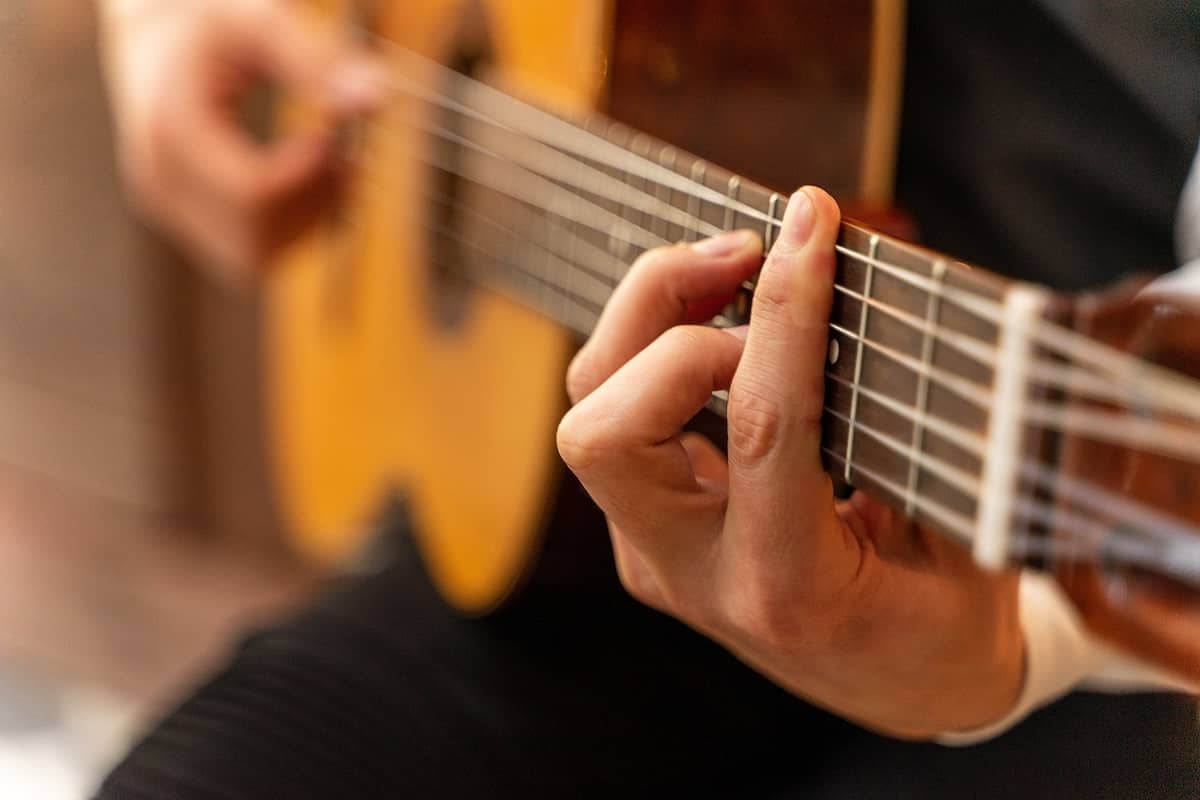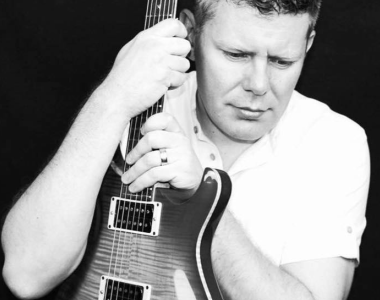Guitar Chords, Demystified: From Building Blocks to Beautiful Progressions

Basics of Chord Progressions in Music Theory and Guitar
For anyone interested in cool guitar chord progressions for acoustic guitar (or electric!!), understanding the basics of chord progressions is essential.
Whether you're a beginner or an experienced player, this post will guide you through the key concepts, enhancing your ability to compose, improvise, and understand chord progressions on the guitar.
Understanding Chords and Chord Progressions
Chord progressions
Chord progressions, the sequence of chords in a piece of music, form the backbone of most songs.
Here, I'll explore how to create a chord progression and delve into various types, including beautiful chord progressions for guitar and common patterns like the C major chord progression for guitar - just check out the Chord Randomizer to help you with that!
Chord Definition
A chord is a group of notes played simultaneously or picked out as part of an arpeggio. Understanding this is the first step towards mastering chord progression guitar techniques.
Chord Progression Concept
A chord progression is a series of chords played in a sequence. It's helpful to think of them as the foundational part of a song for the melody, guiding the listener through the emotional journey of a song.

Types of Chords
Major, Minor, Dominant, Diminished, and Augmented. Each type lends itself to different moods, from sad and melancholic to happy and bright, which is crucial in creating beautiful chord progressions on guitar.
Building Chords
Chords are built from scales, using specific intervals. For example, a major chord is formed by combining the root, major third, and perfect fifth intervals.
This knowledge is fundamental and is the theory foundation for using my Chord Randomizer - a chord progression generator for guitar.
The Role of Chord Progressions in Music
Chord progressions minor and major set the tonal foundation of a song. For beginners, understanding how these progressions influence the mood and emotional impact of a song is critical.
Harmony and Mood
Chord progressions create the harmony of a song. Whether you're playing guitar chord progressions for beginners or experimenting with more complex sequences, the progression you choose will significantly influence the song's mood. The relationship to the melody is the key to how the song sounds and how it makes the listener feel.

Common Chord Progressions in Guitar Music
Common chord progressions are crucial for guitarists in any genre, offering a foundation for songwriting and improvisation.
Progressions like the classic I-IV-V in blues and rock, or the intricate ii-V-I in jazz, provide essential frameworks.
These sequences, such as the popular I-V-vi-IV in pop music, are key to creating catchy tunes and versatile arrangements.
Mastering these progressions allows guitarists to play a wide range of songs, develop their musicality, and craft unique compositions, making them indispensable in a guitarist's toolkit.
I-IV-V Progression in C Major:
I (C major): C - E - G
IV (F major): F - A - C
V (G major): G - B - D
This progression is common in blues and rock. In the key of C, it would cycle through C major, F major, and G major chords.
ii-V-I Progression in C Major:
ii (D minor): D - F - A
V (G major): G - B - D
I (C major): C - E - G
Often found in jazz, this progression in C major would involve playing D minor, G major, and then C major.
I-V-vi-IV Progression in C Major:
I (C major): C - E - G
V (G major): G - B - D
vi (A minor): A - C - E
IV (F major): F - A - C
A staple in many pop songs, this progression would go from C major to G major, then A minor, and finally F major.
Each of these progressions has a distinct sound and feel, making them suitable for different styles and moods in music.
By practicing these in various keys, guitarists can enhance their versatility and ability to play a wide range of music.
Roman Numeral Notation
Understanding this notation, which signifies the scale degree, is crucial when using tools like a chord progression generator free online.
Roman numeral notation in music assigns Roman numerals (I, II, III, IV, V, VI, VII) to represent chords based on their position or degree in a scale.
In a scale, each note is given a degree from one to seven. In the key of C major, for example, the first degree (I) corresponds to the C major chord.
Major chords are denoted by uppercase numerals, while minor chords use lowercase numerals.
This system helps musicians identify and play chords in different keys based on their scale positions.
Playing Chord Progressions on Guitar
For beginners learning how to play guitar chord progressions, start with simple sequences and gradually work up to more complex ones.
Transition Tips
Smooth chord changes are key in playing engaging music. This is especially important in genres that rely heavily on guitar, like acoustic and rock.
Transition Tips
Different strumming patterns can completely change the feel of a chord progression, adding depth and complexity to your playing.
Progression Practice Techniques
Exercise Routines
Regular practice is essential, whether you're working on guitar chord progressions for beginners or more advanced sequences.
A chord progression generator can be a useful tool in this process.
Metronome Use
Keeping time with a metronome is crucial, especially when learning new progressions.
Chord Randomizer App
This type of app can be incredibly useful for those looking to improve their guitar chord progressions.
It can help generate ideas and provide a framework for practice.
Need help with your Guitar Playing - Guitar Picking Exercises for Beginners
I offer Live, online Guitar lesson! For more details CLICK HERE
Your Guitar Chord Progressions questions answered
What is the chord progression theory of the guitar?
The chord progression theory of the guitar is a cornerstone of musical composition and improvisation, involving the creation of a sequence of chords in a harmonious and musically pleasing manner.
This theory is pivotal for guitarists, especially beginners learning guitar chord progressions, as it underpins the structure of songs and supports melodic development.
By understanding this theory, guitarists can craft beautiful chord progressions on the guitar, enhancing the emotional impact of their music.
How do you come up with guitar chord progressions?
Creating a chord progression on the guitar involves a blend of music theory knowledge and creativity. Beginners might start with familiar patterns like the I-IV-V, one of the best chord progressions to learn initially.
More experienced players might experiment with various chord combinations, perhaps using a chord progression generator app to inspire new ideas.
The key is to understand the relationship between chords within a key and to listen attentively to the progression's musical flow and emotional resonance.
What is the basic music theory chord progression?
Basic music theory behind chord progressions is grounded in the understanding of scales and keys, forming the basis for harmonious chord sequences.
The classic I-IV-V progression, integral in guitar chord progressions for beginners, exemplifies this concept, using chords built on the first, fourth, and fifth notes of a major scale.
This progression, and others like it, are foundational in crafting songs across various genres and are a great starting point for anyone interested in music composition and creating beautiful chord progressions on the guitar.
What is the 3 chord rule?
The 3 chord rule simplifies music theory, suggesting that many songs can be played with just three chords: the I, IV, and V of a key.
This principle is especially useful for beginners learning guitar chord progressions, as it demonstrates the power of simplicity in music.
The rule is a staple in genres like blues and folk, where the beauty often lies in the straightforwardness of the chord progression.
It's a practical and effective approach for those new to music, providing an accessible way to start playing songs and understanding the basic structures of musical composition.
Guitar Practice Checklist
Check out my Guitar Techniques List HERE

About ME
adrian Curran guitar Tutor
Hi there, guitar friends! Adrian here, from Warrenpoint, Co. Down Ireland bringing you 27 years of guitar love!
Whether you're just pickin' your first string or shredding solo lines, I've helped hundreds (literally!) find their musical happy place.
My lessons, for both acoustic and electric players, are all about playing the music YOU love, overcoming challenges with a smile, and discovering the pure joy of making music.
Let's craft your personalised musical adventure, in person or online - come join the guitar fun.




